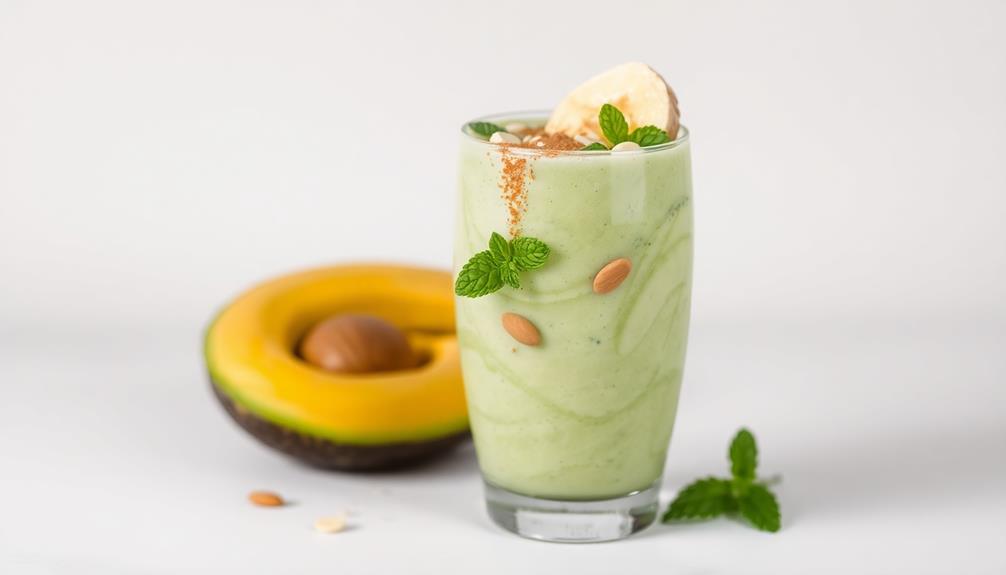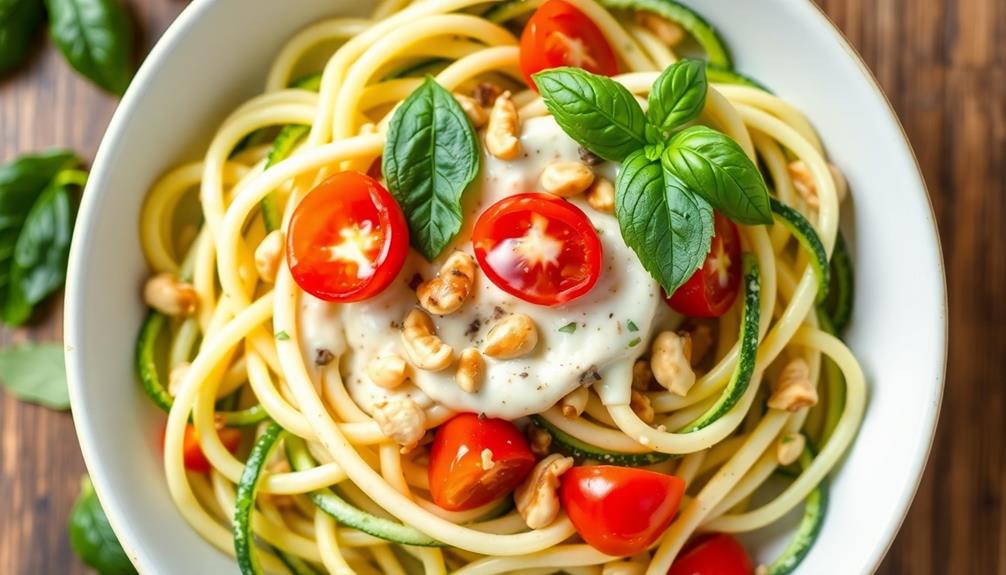When following a low-FODMAP diet, you'll want to closely read food labels to avoid hidden high-FODMAP ingredients that can cause digestive issues. Common culprits include garlic, onion, and wheat-based products – they often sneak into processed foods, sauces, and even beverages. Check ingredient lists carefully and learn to spot these sneaky additions. Knowing what to watch for will help you make better choices that keep your gut happy. And if you want even more tips on navigating a low-FODMAP lifestyle, there's plenty more to explore.
Key Takeaways
- Carefully check ingredient lists for common hidden FODMAPs like garlic, onion, wheat, and sweeteners like honey.
- Be wary of processed foods, as they often contain high-FODMAP ingredients like thickeners and added sugars.
- Sauces, dressings, and condiments may unexpectedly contain high-FODMAP ingredients, so read labels thoroughly.
- Certain beverages, such as those sweetened with high-FODMAP sweeteners, can also be problematic on a low-FODMAP diet.
- Staying vigilant and informed about evolving FODMAP research helps identify new potential triggers in processed and packaged foods.
History
The low-FODMAP diet was first developed in the early 2000s by researchers at Monash University in Australia. They discovered that certain carbohydrates, known as FODMAPs, could trigger digestive issues in people with conditions like irritable bowel syndrome (IBS).
The diet involves reducing or eliminating high-FODMAP foods to help manage these symptoms.
Over the years, the low-FODMAP approach has gained popularity worldwide as an effective way to identify and manage food triggers. Researchers continue to study the science behind this diet, refining the list of high- and low-FODMAP foods.
Today, the low-FODMAP diet is recognized as a valuable tool for people seeking relief from gastrointestinal discomfort. By understanding the history and principles of this approach, you can better navigate the grocery aisles and find foods that fit your dietary needs.
Recipe
A low-FODMAP diet can be an effective way to manage digestive issues, but it can also be a challenge to find recipes that fit within the guidelines. This recipe for a delicious and satisfying meal is designed to be low in FODMAPs, making it a great option for those looking to improve their gut health.
This dish features a variety of fresh and flavorful ingredients that are carefully selected to be low in FODMAPs. By focusing on whole, unprocessed foods and avoiding common trigger ingredients, you can enjoy a satisfying meal without the discomfort often associated with high-FODMAP foods. There are many lowfodmap pasta options available, such as rice, quinoa, or corn-based varieties that can easily be incorporated into this dish. With the right ingredients, you can create a delicious and satisfying meal that won’t leave you feeling bloated or uncomfortable. By making thoughtful choices and being mindful of your body’s needs, you can still enjoy a wide variety of flavorful foods without sacrificing your digestive comfort.
Ingredients:
- 1 cup quinoa, rinsed
- 1 cup diced zucchini
- 1 cup cherry tomatoes, halved
- 1/2 cup crumbled feta cheese
- 2 tablespoons olive oil
- 1 tablespoon lemon juice
- 1 teaspoon dried oregano
- Salt and pepper to taste
Instructions:
Cook the quinoa according to package instructions. In a separate bowl, combine the zucchini, cherry tomatoes, and feta cheese. Drizzle with olive oil and lemon juice, then sprinkle with oregano, salt, and pepper. Toss gently to coat.
Serve the quinoa and vegetable mixture together, and enjoy your delicious and gut-friendly meal.
When preparing this dish, it's important to be mindful of portion sizes, as even low-FODMAP foods can cause issues if consumed in excess. Additionally, be sure to use high-quality, fresh ingredients to maximize the flavor and nutrition of the meal.
With a little planning and attention to detail, you can create a satisfying and low-FODMAP meal that will leave you feeling your best.
Cooking Steps
Now that you've got all the ingredients ready, let's dive into the cooking steps.
First, combine everything in a bowl. Then, add the wet ingredients and give it a good stir.
Finally, pop it in the oven at 375°F for about 30 minutes.
Don't forget to let it cool down before serving, and top it off with some fresh herbs for a nice finishing touch.
Step 1. Combine Ingredients in a Bowl

With ingredients gathered, it's time to bring them together in a mixing vessel. Grab a medium-sized bowl and place it on your counter or table.
Start by adding the low-FODMAP ingredients you've prepared, such as gluten-free flour, lactose-free milk, and your choice of low-FODMAP vegetables. Gently mix the ingredients using a wooden spoon or silicone spatula, being careful not to overmix. Incorporate the ingredients until they're well combined, but avoid beating the mixture too vigorously, as this can develop the gluten and make your final dish tougher.
Once the ingredients are mixed, take a moment to give the bowl a quick inspection. Make sure there are no pockets of dry ingredients hiding at the bottom. If needed, use your spoon or spatula to gently fold the mixture a few more times to ensure even distribution.
With your ingredients combined, you're now ready to move on to the next step in your low-FODMAP recipe. Remember to work carefully and pay attention to the texture and consistency of your mixture.
Step 2. Add Wet Ingredients

After combining the dry ingredients, you'll want to incorporate the wet ingredients. This is where your dish really comes together.
Start by adding the wet ingredients, like milk, eggs, or oil, to the dry mixture in the bowl. Use a whisk or spoon to gently stir everything together until it's well-combined and there are no dry pockets.
Be careful not to overmix, as this can make your baked goods tough. Once the wet and dry ingredients are nicely incorporated, your low-FODMAP batter or dough is ready for the next step.
Whether you're making muffins, pancakes, or a casserole, this crucial wet ingredient step ensures your final product has the right texture and consistency.
Take your time and pay attention to how the mixture looks and feels – that will help you achieve the perfect low-FODMAP result every time.
Step 3. Bake at 375°F for 30 Minutes

Preheat your oven to 375°F. This temperature is perfect for baking your low-FODMAP treats to golden perfection.
Once your oven is nice and toasty, it's time to pop those goodies in. Carefully slide the pan or baking dish onto the middle rack, making sure there's enough space for the heat to circulate around the food. Set a timer for 30 minutes and let the magic happen.
During this baking time, the dry ingredients will blend seamlessly, and the wet ingredients will meld together, creating a delightful texture. The heat will transform the mixture, locking in all the wonderful flavors you've carefully selected.
Keep an eye on things, and if the tops start to brown too quickly, you can loosely cover the dish with foil to prevent over-browning.
When the timer goes off, use oven mitts to safely remove the baked goods. Let them cool for a few minutes before serving or storing. Enjoy your low-FODMAP creation!
Step 4. Cool Down Before Serving

Once your low-FODMAP treats have finished baking, you'll want to let them cool down before serving. This important step allows the baked goods to firm up and prevents them from falling apart when you try to remove them from the pan or plate them. It also helps the flavors meld together for a tastier result.
First, take the pan or baking sheet out of the oven and set it on a wire rack or heat-safe surface. Avoid placing it directly on the counter, as that can cause the bottom to become soggy. Let the treats cool for at least 10-15 minutes. Larger items like cakes or casseroles may need up to 30 minutes.
Use this time to prepare any garnishes or toppings you'll be adding.
Once cooled, you can carefully transfer the low-FODMAP treats to a serving dish. Handle them gently to retain their shape. Now they're ready to enjoy! The cooling process ensures a perfect texture and presentation every time.
Step 5. Garnish With Fresh Herbs

To add a vibrant finishing touch, garnish your cooled low-FODMAP treats with fresh herbs. Herbs not only look beautiful, but they can also enhance the flavors of your dishes.
Consider sprinkling some chopped parsley, basil, or cilantro over your low-FODMAP desserts or savory snacks. Mint leaves make a lovely garnish for icy treats like sorbet or granita.
Remember to choose herbs that are low in FODMAPs, such as rosemary, thyme, or chives. Avoid high-FODMAP herbs like garlic, onion, or leek.
Gently tear or snip the leaves just before serving to release their aroma and maximize their fresh taste. Arrange the herbs artfully on top of your creations for a professional-looking finish.
Their vibrant colors and delicate flavors will elevate your low-FODMAP dishes, making them both visually appealing and delicious.
Experiment with different herb combinations to find your favorite flavor pairings.
Final Thoughts
As you've explored the world of low-FODMAP diets, reading labels has become a crucial skill. You've learned to spot hidden sources of FODMAPs, which can make or break your digestive comfort.
But the journey doesn't end there. Moving forward, remember to stay vigilant and keep up with the latest low-FODMAP research. New ingredients and products are constantly hitting the market, so it's important to stay informed.
Don't be afraid to reach out to your healthcare team for guidance on navigating the ever-evolving low-FODMAP landscape.
Most importantly, be patient with yourself. Adapting to a low-FODMAP diet takes time and practice. Celebrate your successes, and don't be discouraged by the occasional slip-up.
With diligence and self-care, you can find the balance that works best for your body and your well-being. Keep reading those labels, and enjoy the journey towards a healthier, happier gut!
Frequently Asked Questions
Is the Low-Fodmap Diet Suitable for Weight Loss?
The low-FODMAP diet isn't primarily designed for weight loss, but you may lose weight on it. Focus on selecting nutritious, high-fiber foods, and be mindful of your portions. The diet's main goal is to manage digestive symptoms, not weight management.
Can the Low-Fodmap Diet Help With IBS Symptoms?
Absolutely! The low-FODMAP diet can effectively manage IBS symptoms by eliminating high-FODMAP foods that trigger digestive issues. You'll likely experience reduced bloating, gas, and other uncomfortable IBS-related effects when following this diet under the guidance of a healthcare professional.
How Long Does It Take to See Results on the Low-Fodmap Diet?
You can typically see improvements in IBS symptoms within 2-4 weeks on the low-FODMAP diet. However, it may take up to 6-8 weeks to fully eliminate symptoms as your body adjusts to the new dietary changes.
Can I Have Dairy Products on the Low-Fodmap Diet?
You can have some dairy products on the low-FODMAP diet, but you'll need to be mindful of serving sizes. Lactose-free milk, hard cheeses, and yogurt with live cultures are usually well-tolerated in moderation.
What Are Some Common Mistakes to Avoid on the Low-Fodmap Diet?
You'll want to avoid common mistakes like consuming too many high-FODMAP foods, not properly monitoring portion sizes, and not reading labels carefully for hidden FODMAP-containing ingredients. Stick to the recommended low-FODMAP foods and be diligent about your intake to see the best results.










